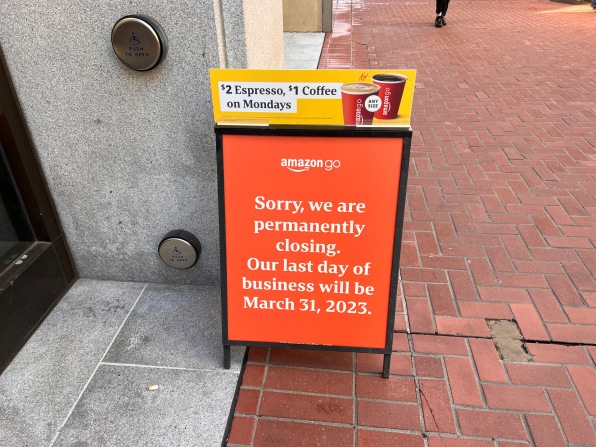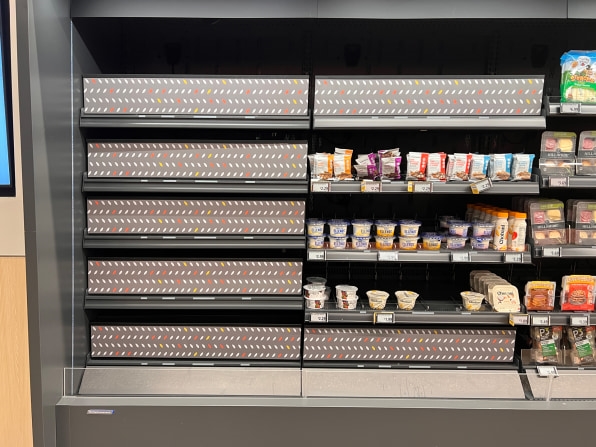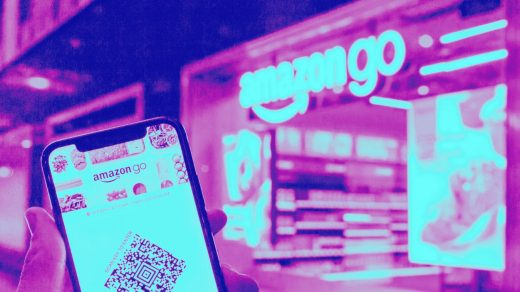The tragic blown promise of Amazon Go
This story is from Fast Company’s new Plugged In newsletter, a weekly roundup of tech insights, news, and trends from global technology editor Harry McCracken, delivered to your inbox every Wednesday morning. Sign up for it—and all our newsletters—here.
Starting April 1, my workday regimen here in San Francisco is in for a change. The city’s four Amazon Go convenience stores—which leverage Amazon’s “just walk out” technology to dispense with checkout lines—are all closing. That includes the one right upstairs from my subway stop, where I’ve made nearly 200 purchases during its less than four years of existence, a large chunk of which was disrupted by COVID-19.
The shutterings are part of an ongoing downsizing at Amazon—most notably including 27,000 layoffs across the company—and also affect two locations in Manhattan and two in Amazon’s hometown of Seattle. Twenty-three Amazon Go stores will survive, including eight in New York City (two operated in partnership with Starbucks), five in Chicago, and five in Seattle. Amazon has expanded the “just walk out” technology it pioneered at Go to 28 Amazon Fresh groceries (for now) in the U.S., another 20 in the U.K., and 2 Whole Foods Markets. It also continues to license the technology to other retailers.

None of these survivors are anywhere near where I live, so this seems to be the end of my grab-and-go days at Amazon retail, at least for now, with the possible exception of occasional visits during my travels. The fact that I’ve given Amazon Go so much business proves that I found value in being able to duck in and out of a convenience store as quickly as possible. But reality fell far short of what might have been—an upshot that typifies Amazon‘s experiments in physical retail, which have often ended in disappointment.
One of the most intriguing things about shopping at Amazon Go was watching other people react to it. When my local Go was new, the entrance was often crowded with curious passers-by who were fascinated by the thought of an Amazon convenience store, even before they learned they could just pick up stuff and leave. In the early days, getting in required having a smartphone with the Amazon Go app, which was enough of an obstacle that I saw more than one would-be customer give up and leave before getting past the turnstile.
Once you’d gained entry to the store, the technology—which used cameras on the ceiling to watch what you plucked from shelves—may have been creepy, but it worked. (Most of the time, that is: Once, when I attempted to dispense myself a drink from the fountain machine and realized mid-pour that it was out of order, I got charged anyway and had to request a refund.) Judged purely as a convenience store, however, Go was surprisingly lackluster. There was some tasty, bargain-priced fresh food: I’ll miss the Vietnamese chicken salad. But the overall selection couldn’t compete with the most mundane human-staffed competition.
For reasons outside of Amazon’s control, its timing also turned out to be lousy. Shortly before COVID-19 brutalized physical retail of all kinds, the Go store I habituated closed for a major remodeling, which turned out to involve shrinking the footprint devoted to products and adding more tables and chairs for in-store eating. Even once the store reopened mid-pandemic, the seating would be roped off for eons. When finally made available, it went largely unused.
Then there’s the fact that operating urban stores of any kind may not be the business it once was—especially in San Francisco, whose downtown has yet to return to pre-COVID bustle. I realized only recently that both of the 7-Elevens near my office had quietly vanished, leaving the area a bit of a convenience-store desert even before the Go closures kick in.
Especially after its pandemic reopening, my Amazon Go didn’t seem to be trying very hard. Wide swaths of shelf space went empty or was reallocated to 12 packs of soft drinks. The offerings that were available rarely seemed to change, reducing any incentive to browse for new discoveries. And the only time I ran into a friend at the store, she was there to return an Amazon purchase she’d made online—an Amazon Go sideline that seemed quite popular.

Other than its embrace of newfangled technology and the product-return counter, Amazon Go didn’t even feel all that Amazonian, at least in ways that worked in its favor. It sure didn’t live up to the company’s brand promise of offering every product you could ever need, and just as many that you probably wouldn’t. Moreover, the utilitarian nature of Amazon shopping just isn’t as appealing when translated into physical retail: When my colleague Mark Wilson dropped by one of Manhattan’s hybrid Starbucks/Amazon Go outlets in 2021, it struck him as resembling “a bodega crossed with a morgue, or perhaps a vending machine extrapolated into concrete.” Ultimately, the fact that humanity had been stripped out of the experience—except for the security guard up front saying goodbye when customers left—didn’t seem like a plus.
Whatever the fate of Amazon’s remaining Go outposts, I hope other companies push forward with cashierless retail. A startup called Grabango works with existing retailers to implement checkout-free technology into their stores: The nearest one to me, a Chevron ExtraMile location in San Ramon, California, is 32 miles away. That hardly qualifies as convenient—but I just might make the trek to see if it nails the idea in ways that Amazon Go never quite has.
If you have comments on this story or ideas for future Plugged In newsletters, drop me a line at hmccracken@fastcompany.com.
(19)



